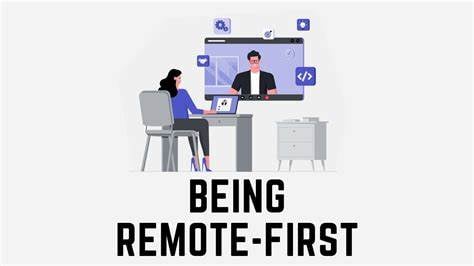In the modern age, there’s a new bunch of remote terms being bandied about to describe how friendly (or unfriendly) a company is towards remote work. You might have heard of the main two remote work models before:
- Remote first
- Remote friendly
In this article, we’ll explain what they both mean for the business, and for the employee.

What is Remote First?
If a company is remote first, it means they prioritize remote work. Not only do they offer remote work to almost all employees, they actively encourage it. Few, if any, employees will be required to work from an office or another on-site location. Instead, employees will work from home, a co-working space, or wherever they damn please.
Remote first is not an entirely new approach, but it did gain mainstream popularity during the COVID 19 pandemic. Since then, this remote work model has remained a top choice for a number of online businesses due to the costs saved on office space, and the general happiness and productivity of remote workers.
What is a Remote First Company?
A remote first company is a business that employs a remote first strategy, encouraging its employees to work remotely. These types of companies may have an office, but they don’t force their employees to go. More likely, especially with smaller remote first companies, is that they don’t have an office at all.

This, of course, isn’t always the case. You’ll often get a remote first company that still asks its employees to come in every now and then, or for team building exercises. But the short and fast rule is that a company that bills itself as remote first is generally not going to require you in the office.
One of the main qualities of remote first work is that it often allows for asynchronous communication, meaning team members don’t necessarily need to be active at the same time. This allows remote first companies to rent virtual offices across the globe without having to worry about the physical office, and to hire people from all over the planet without any interruption or need for relocation.
16% of the world’s companies are fully remote! While that’s still a low number, these companies literally have no office or headquarters whatsoever. All their employees work from wherever they want. A lot of software or tech companies are remote first, like Zapier, InVision, and, of course, tl;dv!
What are the Benefits of Remote First?
Remote first businesses aren’t just shooting in the dark and trying to attract nomads. There are several clear-cut advantages to running a remote first company.
- Save money. In the world of business, there aren’t too many better advantages than saving money. By reducing their physical footprint, remote first companies can save on office costs and rentals and use that capital elsewhere.
- Deeper talent pool. If you’re limiting yourself to hiring people in your immediate area, you’re limiting your potential to grow. In a remote first environment, talent recruiters have access to a far deeper talent pool. They can even hire people from different countries if it suits their organization, without needing to worry about relocation packages. This is particularly great for roles where there is a distinct lack of affordable local talent, like IT roles.
- Asynchronous communication. Remote first companies often allow for asynchronous communication. Your team does not have to be active at the same time to get the job done. They can work from several different time zones without any interruption.
- Flexibility. A remote first approach to business gives you unlimited capacity to expand. It makes scaling easy. No longer do you need to worry about how to expand your physical space to make room for new employees. If a new hire is needed, it can be implemented as quickly as you need it to be.
- Happier employees. Generally, employees working for a remote first company report being more than 20% happier than employees who have to work in the office full-time. It also boosts quality of life by eliminating commute time and saving on transport costs, among other things.

What is Remote Friendly?
Remote friendly is where employees are allowed to work remotely regularly, but not 100% of the time. A remote friendly company is likely to offer remote work part of the time, but perhaps not to every employee. A general rule of thumb is that if a business is remote friendly, it will probably offer its employees 1-3 days out of the office per week.
This is one of the emerging remote work models that a large number of businesses adhere to today. It’s a good mid-point for those businesses that didn’t start as a remote business and don’t want to take the risk in switching their entire organization.
What is a Remote Friendly Company?
Remote friendly companies offer the ability to work from home at least part of the time. They see the benefits of remote first, but are perhaps restricted with how much they can cut back on their physical presence. A lot of pre-established big companies switched to remote friendly during the pandemic and stayed because of the benefits it brought them.

Remote friendly companies usually have at least one office, sometimes multiple, in which the employees can attend on their in-office days. Some of the biggest companies in the world are now remote friendly: Amazon, Google, and Adobe, for example.
One of the main distinctions between remote friendly and remote first is down to the time zones, too. A remote friendly company usually relies on synchronous communication – i.e they want the entire team available at the same time.
What are the Benefits of Remote Friendly?
Remote friendly, otherwise known as hybrid work, is a remote work strategy that tries to balance the best of remote first and traditional in-office work. As such, there are plenty of advantages. It might not be the master of either one, but it tries its best to be the Jack of all trades.
- More flexible than the 9-5. While remote friendly jobs are not as flexible as remote first roles, they are certainly more flexible than the traditional 9-5.
- Reduce costs. Remote friendly companies can often cut back on infrastructure, without necessarily removing it in its entirety. This allows remote friendly businesses to save on costs, while still providing office space. One of the usual ways this is done is by running a hybrid scheme where some employees work from home on specific days while others come into the office, and vice versa.
- Happier employees. In general, employees that get to work from home at least some of the time come out happier than those stuck in the office permanently. It also gives managers the ability to track productivity inside and outside the office to make data-backed decisions further down the line.
Remote First vs Remote Friendly
So, now you know the difference between the two, it’s time to decide which is the best for you and your business. Remote first usually comes out on top in terms of saving money, boosting employee happiness, and scalability, but it’s not possible for all companies to go remote first.

In fact, there are a number of industries in which remote work won’t really work at all. Anything involving gastronomy, hospitality, or medical work, for example, is simply off the cards. Similarly to this, there are some industries that can work remotely sometimes, but not all the time (or not every employee), like engineering or architectural work. It really depends on what your company does, and how it operates.
As stated earlier, big businesses like Google and Amazon have reduced their in-office time and become remote friendly. However, it’s unlikely they will go fully remote as they have long-established methods of working together in-house, not to mention they have a lot of office real estate in their name. It was a wiser decision for them to cut back than to get rid of it all entirely. On top of this, Amazon warehouses still need humans to operate, even with the best warehouse management systems in place. Similarly, third-party logistics providers depend on advanced 3PL WMS solutions, but human labor remains essential to manage and operate their warehouses effectively.
However, as remote friendly work gains traction, you might view it as a stepping stone to remote first. If the remote work is going well, and productivity is the same or higher, then there is no need to expand physically from a remote friendly business. Rather, you can expand digitally.
Remote Work Tools
While remote friendly businesses might make use of some remote work tools, it’s the remote first teams that find remote tools essential. For them to work asynchronously, particularly among larger teams, they need to have a whole network of interconnected remote work tools that are interoperable with one another.
First and foremost, asynchronous remote-first teams need a virtual meeting tool that can record, transcribe, and translate online meetings. Enter tl;dv.
Meet tl;dv!
Not only is tl;dv great for keeping track of internal meetings, sales calls, customer support calls, employee interviews, and user research, it’s also ideal for reducing time in meetings. You can use a virtual meeting tool to attend in your place and record the entire thing. In fact, with tl;dv, our number one pick for remote first teams, you can even get AI notes and summaries, timestamps from other meeting participants that direct you to the most relevant parts, and even the ability to make clips and highlight reels of your calls so you can quickly catch up on what you’ve missed.
tl;dv was designed by a remote first team for remote first teams. It knows the struggles that asynchronous teams can face, and it goes above and beyond to resolve them. It makes staying in touch with your team easier than ever – regardless of where (or when) they are!
Research shows that unproductive meetings cost around $37 billion annually and waste 24 billion working hours! tl;dv combats this, freeing up your team’s schedules and allowing them to be paid for creating, not prepping for unnecessary meetings.
@tldv.io Makes perfect sense. #meeting #comedy #corporate #meetings #9to5 #firstday
♬ original sound - tldv.io - AI Meeting Recorder
Even better, tl;dv integrates with over 3,000 work and productivity tools, so you can be sure that your workflow will remain intact. You can even get started with unlimited call recordings and transcripts (with laser precise speaker recognition) for free today!
Other Remote Work Tools
If you’re working remote first, you’ll want to check out the following tools:
- Trello, Asana, or Monday. These card-sorting softwares are all about organizing your day-to-day tasks, and marking them as complete. It allows you to maintain a sense of organization even if working fully remotely.
- Google Meet, Zoom, or MS Teams. tl;dv is compatible with all three of these video conferencing tools. It’s essential to have one that you make the company default.
- Hotjar, Maze, and UserBrain. User testing tools are a must-have for those developing software.
- Figma, SketchUp, or Adobe Creative Cloud. Depending on your graphic needs, these tools are all remote friendly and can be used in conjunction with most of the other tools on this list.
- Salesforce, HubSpot, or Pipedrive. These three tools are just a handful of many CRM softwares that can help you organize your customer relations.
- Apollo, LeadIQ, and Cognism. These powerful remote tools can be used to improve your lead quality and attract new leads. You can use them for hiring or prospecting.
Deskbird. A hybrid work management platform that simplifies desk booking, meeting room scheduling, and enhances the employee experience in physical office spaces.
Remote First or Remote Friendly?
The decision is yours. Based on your type of business, your current physical footprint, and your analysis of the above remote work models, you can make the decision for your own business.
Whether you opt for remote first or remote friendly, make sure you download the free version of tl;dv and give it a whirl. If you’re going remote, tl;dv will make your life easier.





